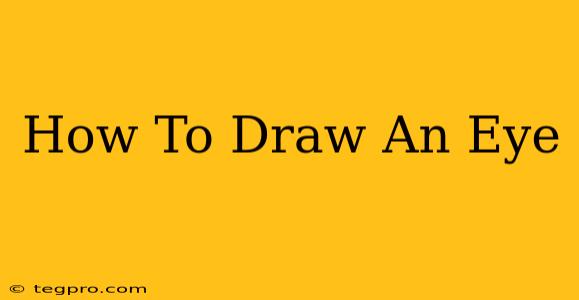Drawing a realistic eye can seem daunting, but with a little practice and the right techniques, you can master this fundamental skill. This guide breaks down the process into simple, manageable steps, perfect for beginners. We'll cover everything from basic shapes to adding intricate details, helping you create captivating and lifelike eyes.
Understanding the Anatomy of an Eye
Before you even pick up your pencil, it's helpful to understand the basic anatomy of an eye. This knowledge will inform your drawing and ensure accuracy. Key elements include:
- The Iris: The colored part of the eye. Its shape and color significantly impact the overall look.
- The Pupil: The black circle in the center of the iris. Its size changes depending on the light.
- The Sclera: The white of the eye. This isn't perfectly white; it often has subtle shadows and variations in tone.
- The Highlights: These are bright spots reflecting light, giving the eye its shine and realism.
- Eyelashes: These add crucial texture and detail.
Step-by-Step Guide to Drawing an Eye
Let's get started! Follow these steps to draw a realistic eye:
Step 1: Sketching the Basic Shapes
Begin by sketching a slightly almond-shaped form. This will be the overall shape of your eye. Don't worry about perfection at this stage; it's just a guide.
Step 2: Adding the Iris and Pupil
Inside the almond shape, draw a circle for the iris. Then, draw a smaller circle within the iris for the pupil. The pupil's size will determine the overall mood and lighting of the eye.
Step 3: Defining the Highlights
Add small, bright circles to represent the highlights reflecting off the eye. These are crucial for realism. Their placement and size will vary depending on the light source.
Step 4: Shading the Iris
Using a soft pencil, start shading the iris. Leave the highlight areas untouched. Gradually build up the darkness around the pupil, creating depth and dimension. You can create a subtle gradient, making the iris appear more three-dimensional.
Step 5: Adding Details to the Iris
Add subtle texture and detail to the iris. Real irises have intricate patterns and variations in color. Use varying pencil pressure to create depth and realism. Consider adding small lines or dots to suggest texture.
Step 6: Defining the Sclera
Lightly shade the sclera, leaving some areas brighter than others. This creates depth and adds subtle shadows. Don't make it stark white!
Step 7: Drawing the Eyelashes
Use short, delicate strokes to draw the eyelashes. Remember, eyelashes curve and vary in length. Pay attention to the direction of their growth.
Step 8: Refining and Blending
Use a blending stump or your finger to gently smudge and blend the shading, creating a smooth transition between tones. This will enhance the realism of your eye drawing.
Tips for Success
- Use References: Looking at real eyes or photos of eyes will greatly enhance your accuracy.
- Practice Regularly: The key to improving your drawing skills is consistent practice. Draw eyes frequently.
- Experiment with Different Techniques: Try different shading techniques, pencils, and erasers to find what works best for you.
- Don't Be Afraid to Make Mistakes: Mistakes are a part of the learning process. Learn from them and keep practicing.
Mastering the Art of Eye Drawing
Drawing a realistic eye is a rewarding experience that improves with practice. By following these steps and practicing regularly, you'll soon be able to create stunningly lifelike eyes. Remember to focus on the details, use references, and most importantly, have fun! Now grab your pencils and start creating!

